Force Plates 101: What are they and why are they used?

About the Author
Jo Clubb is Founder and Sports Science Consultant at Global Performance Insights, which provides sports science support to professional teams, athletes, practitioners, and sport tech companies all around the world. Drawing from her years of experience in high performance including the Premier League, NHL, NFL and more, she shares sports science insights through her blog, YouTube channel, and scientific publications and textbooks.
In this article, Jo discusses what force plates are and how VALD’s ForceDecks technology works.
The Evolution of Force Plate Technology
In the early days of commercialisation, force plates were large, cumbersome, and required manual analysis to transform the raw data collected. This limited their usage to biomechanics laboratories. However, force plates have since evolved into portable versions with increasingly automated analysis, such as VALD’s ForceDecks Dual Force Plate System. This progression has made them accessible for everyday use in diverse settings across health and sport, shifting their utility beyond specialised labs.
force plates have since evolved into portable versions with increasingly automated analysis… This progression has made them accessible for everyday use in diverse settings across health and sport.
How Force Plates Work
A force plate is a platform equipped with sensors, typically piezoelectric or strain gauge. These sensors measure the Ground Reaction Force (GRF) exerted by a person performing various activities on it, like standing, walking, jumping, or running. In ForceDecks, strain gauges housed in the platform’s load cells measure stress, which is proportional to the force applied. These forces are recorded as the individual interacts with the ground, in accordance with Newton's Laws of Motion.
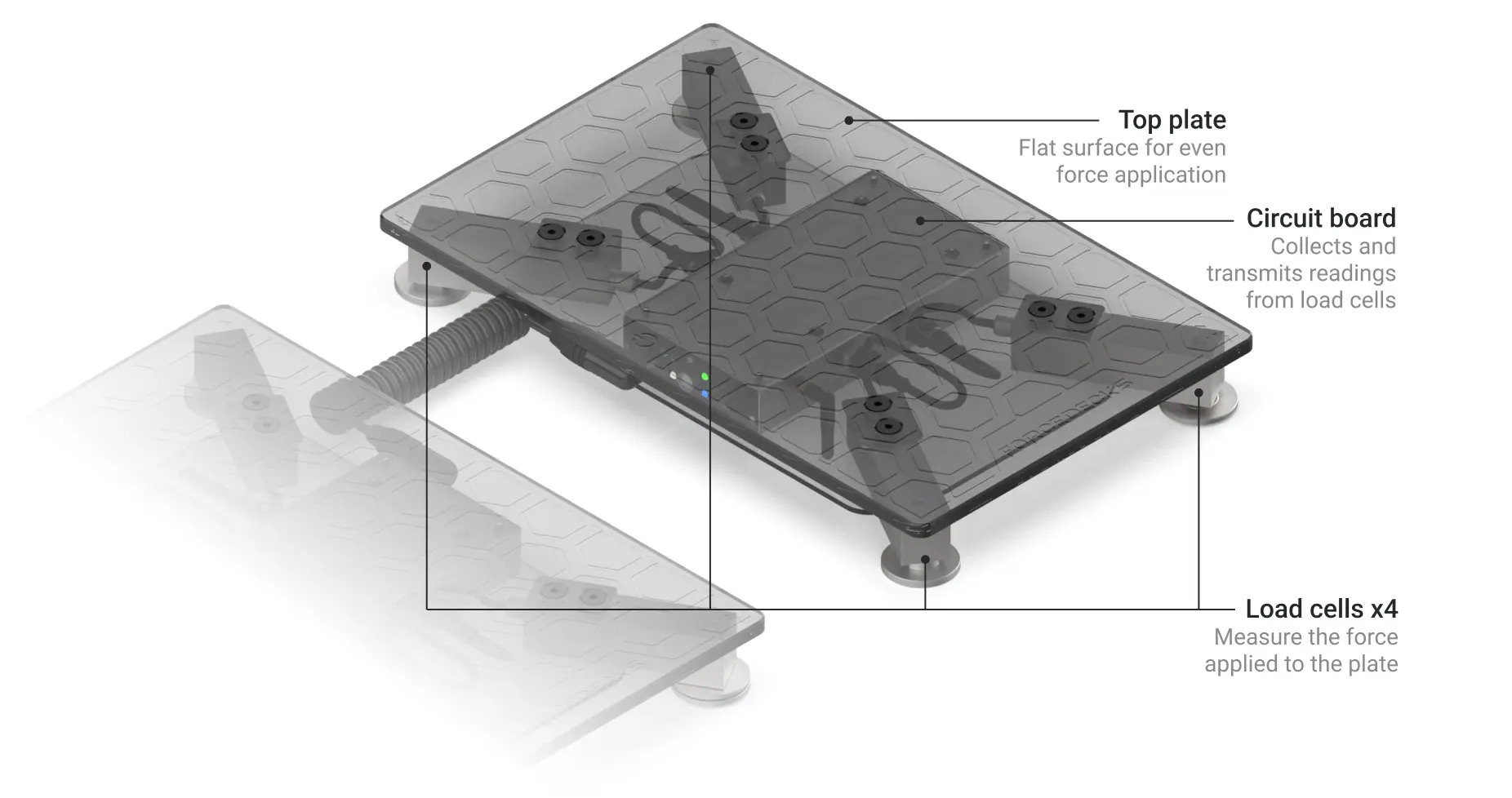
Newton’s Third Law, Action and Reaction, states that for every action (force) in nature there is an equal and opposite reaction. Thus, when an individual stands at rest, the GRF represents their bodyweight. With movement, the GRF changes according to the force the individual applies to accelerate, in accordance with Newton’s Second Law. Force is measured in newtons (N), where 1N is the force required to accelerate an object with a mass of 1 kilogram, 1 metre per second per second (i.e. 1 m/s2).
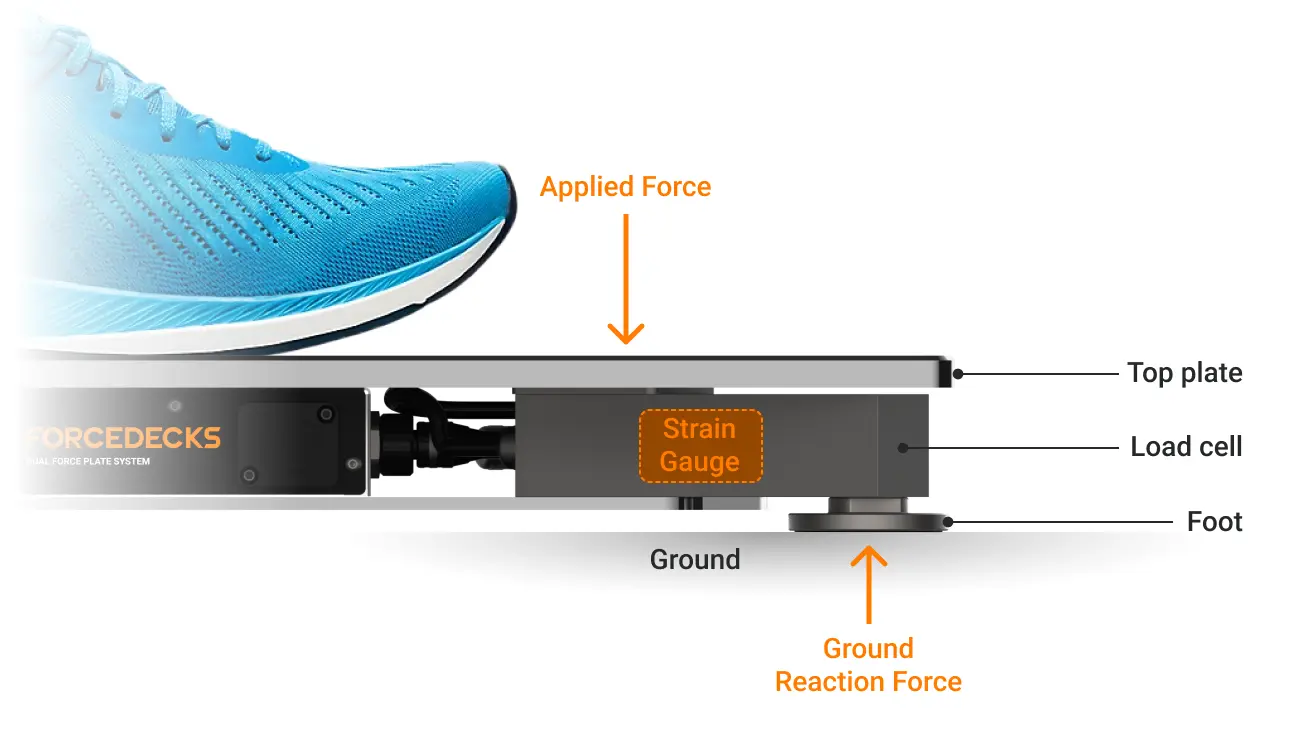
The Force-Time Curve
ForceDecks software visualises the vertical GRF across the movement’s duration, creating the force-time curve. This data is analysed to calculate other parameters including velocity, power, and displacement.
Consider the force-time curve for a common force plate test: the Countermovement Jump (CMJ). The CMJ measures vertical jumping ability, starting with a downwards dip followed by jumping as high as possible. These are conducted with hands on hip to minimise upper-body involvement. In contrast, a CMJ with arms is characterised as an Abalakov Jump. More information on test protocols can be found on the VALD Knowledge Base for CMJ and Abalakov, along with a vast library of other tests.
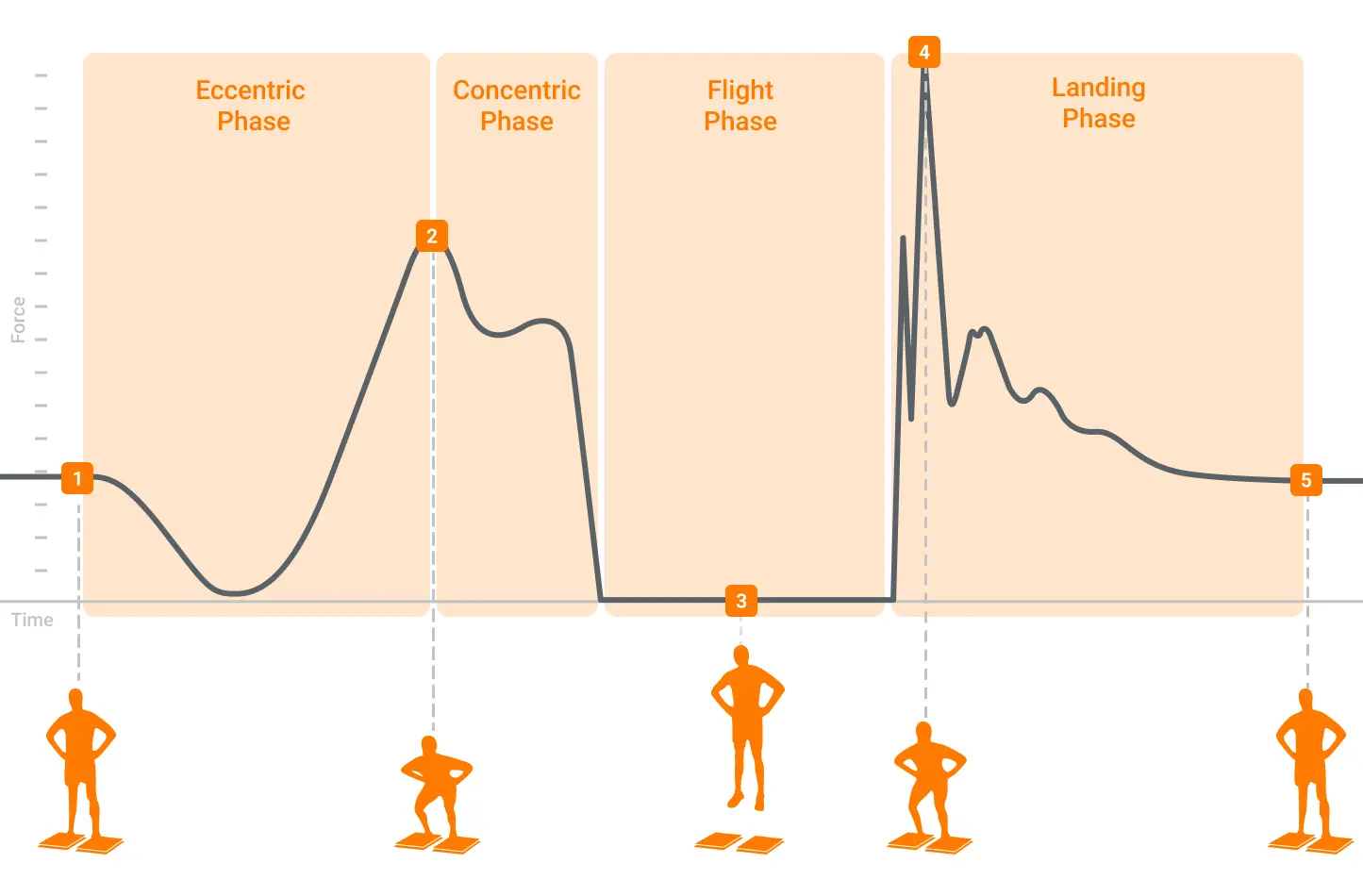
In ForceDecks software, the total vertical GRF is shown by a grey line. In addition, since ForceDecks is a dual force plate system – using two plates, one for each side – the left (blue line) and right (orange line) GRF are also displayed. This enables continuous assessment of symmetry, or asymmetry, between the left and right sides throughout the jump.
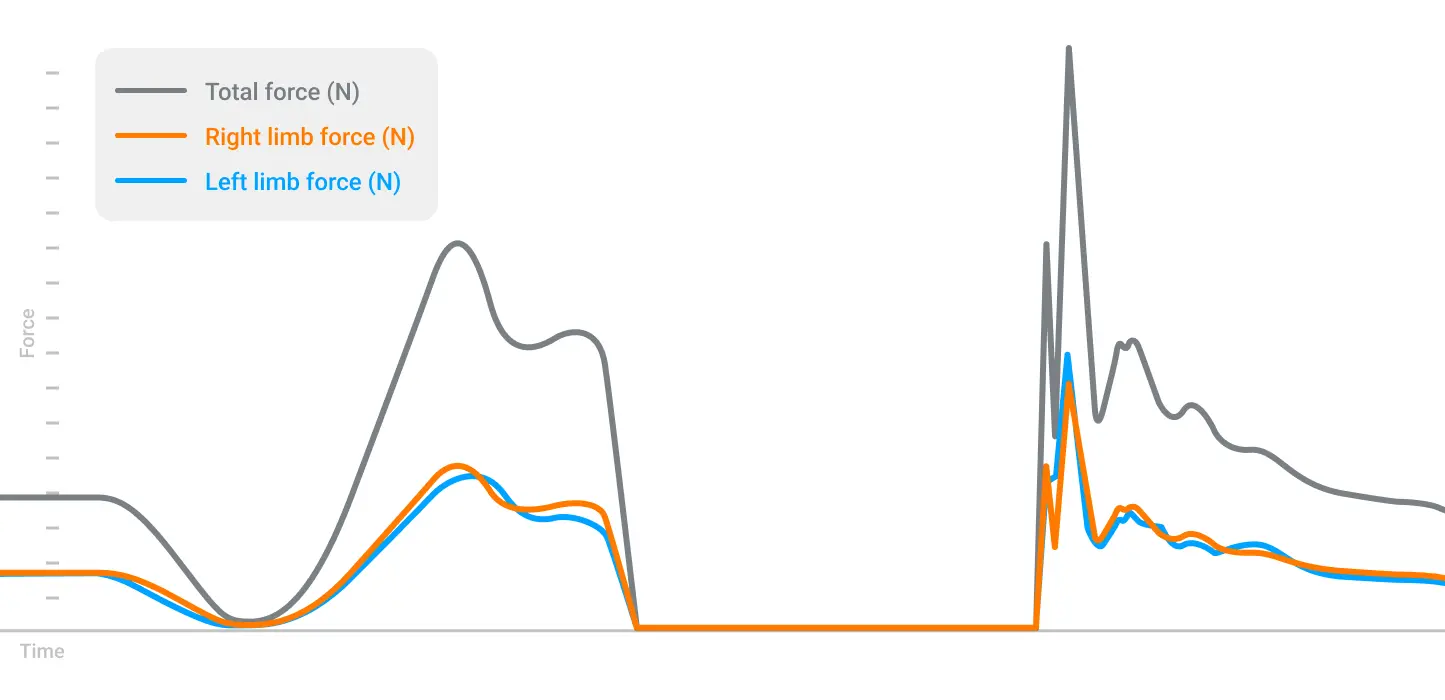
This enables continuous assessment of symmetry, or asymmetry, between the left and right sides throughout the jump.
An acceleration-time curve is derived from the force data (given that force = mass x acceleration), from which the centre of mass velocity is calculated by integrating acceleration with respect to time. With both force- and velocity-time curves calculated, a power-time curve can also be derived (since power = force x velocity). Thus, a multitude of variables related to force, velocity, power, and symmetry are calculated for different jump phases (concentric, eccentric, and landing), as well as specific landmarks.
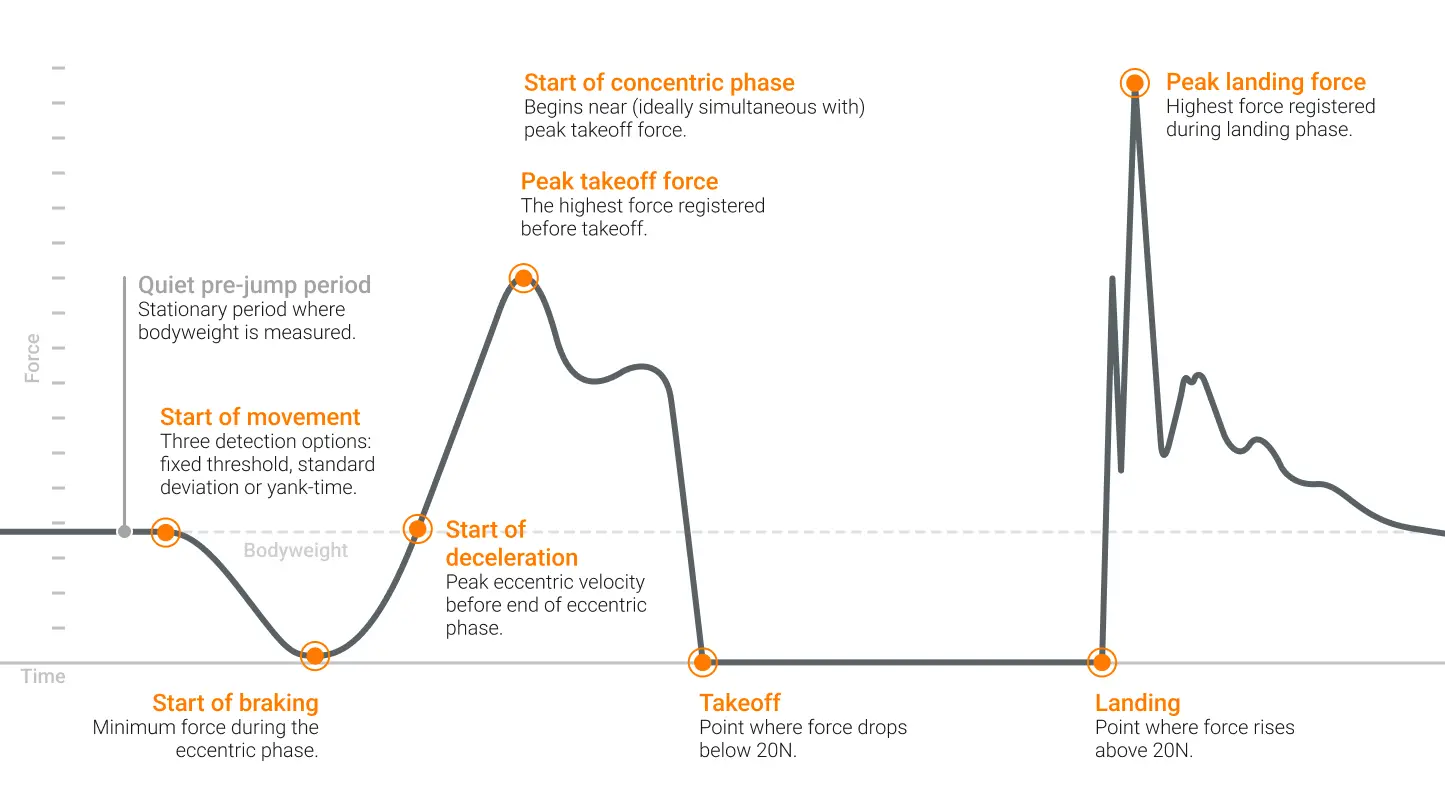
Key Considerations in Force Plate Usage
Proper use and consistent setup of force plates are essential for collecting valid and reliable data. Critical factors include:
- Technical specifications: ForceDecks software is compatible with a range of force plate technologies. Ensure the force plates have sufficient load capacity (maximum force the hardware can tolerate) and sampling frequency (the number of times per second a data point is measured) for your population and applications. More information on these specifications can be found here.
- Mobility and setup: ForceDecks technology is portable, making them ideal for taking to different settings, such as preseason camps, away games, and clinics. However, the hardware should be set up in a suitable location each time, most importantly with a solid and consistent surface below it.
- Calibration: Factory-standard calibration means plates should not need calibrating regularly in the field. Users should, however, check plates are set up correctly and reporting force correctly. Users can verify this by measuring a known load (of at least 50kg/100lb), although there will also be variation in standard weight plates.
- Collection consistency: While controlling external factors is challenging in sports or clinical settings, maintaining consistent routines, testing times, and warm-ups is vital.
- Testing protocol: Use a consistent test protocol for repeatability across trials, individuals, and days. VALD provides an extensive testing protocol library in its Knowledge Base.
- Quiet pre-jump period: Although this falls within the testing protocol, it is such an important point that it is worth reiterating by itself! Accurate body mass measurement before the jump is crucial for subsequent analysis. Therefore, ensure this is accurate by having the individual standing still immediately prior to the jump.
Selecting Force Plates Tests
Broadly speaking, force plates are extensively used for strength and power diagnostics in sports. In healthcare, they assist in clinical analyses of rehabilitation and movement, which is a common application in professional sports as well.
force plates are extensively used for strength and power diagnostics in sports. In healthcare, they assist in clinical analyses of rehabilitation and movement, which is a common application in professional sports as well.
VALD categorises their ForceDecks tests into Jumps, Functional, Balance, and Isometric. Most of the tests within these categories also benefit from VALD’s automatic detection feature, which uses advanced statistical techniques to automatically identify the test conducted based on the force-time curve.
These tests can provide insights into an individual’s athletic capacities, force generation, fatigue status, rehabilitation and return-to-play progress, and left-to-right asymmetries. It is important to keep these applications in mind when deciding which tests to include in an assessment battery (i.e. start with the end in mind). We must respect the time and capacity of our athletes and clients, and so test selection should maximise value while minimising unnecessary burden.
These tests can provide insights into an individual’s athletic capacities, force generation, fatigue status, rehabilitation and return-to-play progress, and left-to-right asymmetries
The CMJ, as already described, offers a near-maximal assessment of lower-body muscle power capability. However, there are a range of other capacities that may be of interest to sports scientists and clinicians, depending on the sport/population, time in season, and injury history and status.
For instance, VALD Physical Therapist Sasha Birge, has described the Plyometric Continuum and how different ForceDecks tests can be used to assess the body’s ability to store and release elastic energy, ranging from a squat assessment to a drop jump.
Force plate applications extend beyond jumps alone. Growing research on isometric training for strength development has simultaneously increased interest in isometric assessments. The isometric mid-thigh pull (IMTP), which is explained in our VALD Athlete Testing series on YouTube, provides a safe and effective assessment of maximal force. This is now more frequently utilised than more demanding and time-consuming maximal strength testing.
Growing research on isometric training for strength development has simultaneously increased interest in isometric assessments
While the IMTP presents a global, full-body assessment of strength, there can also be value in zooming in on multi-joint assessments, such as Alex Natera’s Run-specific Isometric Assessment Battery. This programme seeks to answer the question ‘are returning athletes ‘strong enough’ to run fast?’ and Alex has detailed how he integrates VALD’s ForceDecks into this process.
VALD’s ForceDecks technology offers insights into the intricate dynamics of human movement. Its evolution to a versatile, practical device underscores its importance in understanding and enhancing human performance and health. As technology continues to advance, the potential applications of force plates are bound to expand, offering even deeper insights into the mechanics of movement.
As technology continues to advance, the potential applications of force plates are bound to expand, offering even deeper insights into the mechanics of movement.
If you would like to know more about how to integrate VALD’s human measurement technology into your organisation to help with the engagement of your clients, please reach out here.

